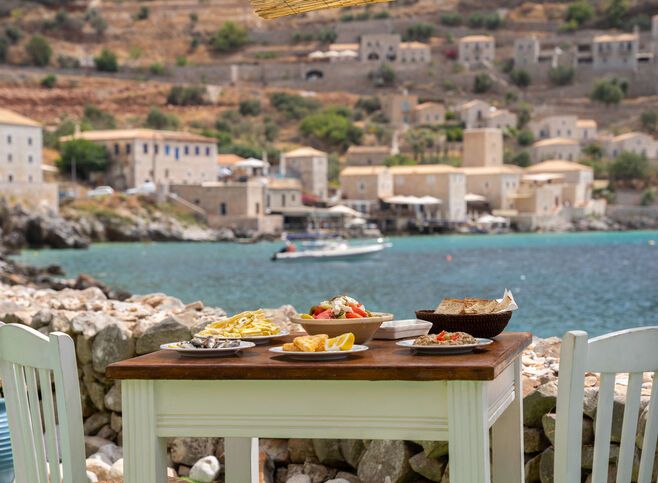A day’s visit to Ancient Olympia, the birthplace of the Olympic Games, won’t be enough, so much is there to absorb at this legendary destination in Greece. The scale of ancient history here never ceases to astound.
The centrepiece of Zeus’ most magnificent sanctuary was the 13.5m-tall gold and ivory statue, dedicated to the king of the gods and created by master craftsman Pheidias. One of the Seven Wonders of the Ancient World, the statue no longer exists but you will appreciate its scale by visiting and you will be able to admire firsthand other famous artefacts, such as the statue of Hermes by Praxiteles.
Both the archaeological site and the museum in Ancient Olympia offer a vivid picture of the splendour, glory and breadth of a civilisation that continues to give so much to the modern world – not just in sporting action but ethics, ideals and sportsmanship.
What to do in Ancient Olympia
Feel the spirit of the original Olympic Games
London, Beijing, Athens…Retracing the history of the Olympic Games back to 776 BC, you arrive at the starting line, where it all began in this gentle, wooded valley in the Peloponnese’s Alpheios River. In Zeus’ honour, every four years, this was the scene of an event in which the whole of the Greek-speaking world took part.
The Olympic Games were more than just athletic competitions. They were panhellenic festivals and took precedence over everything occurring at that time, even wars. During the period of the Games, any hostilities between fractious city-states were suspended and an Olympic Truce was imposed. Such was the Games’ importance that only twice in a thousand years were they interrupted.
Visit the archaeological site of Ancient Olympia
The Sanctuary of Zeus was called the Altis or ‘sacred wood’. It was a walled area, enclosing many monuments and buildings beside the Temple of Zeus. You can admire the Philippeion, a memorial completed by Alexander the Great, the stadium of Olympia, and the Bouleuterion which was the equivalent of today’s organising committee of the Games.
You’ll see arcades, smaller temples and statue pedestals. Some of the structures were residential, while others had an administrative or ceremonial function. Zeus’ temple stood at the centre of everything. You can just imagine being faced with his enormous statue, carved from ivory, its gold glittering in the sunlight! Could there ever have been any doubt that he ruled over heaven and earth?
Take a tour of the original Olympic stadium
This is where the most important competitions took place. Pass under the arched entrance and you’re in a place where countless VIPs rubbed shoulders with the common folk (but not women), all rooting for their heroes. The stadium you see today was built around the same time as the Temple of Zeus, in the 5th century BC.
The hippodrome for chariot races lies to the south of the stadium. Still standing are ruins left from a later age: baths and villas, like the one Roman emperor Nero had constructed as a private residence when he attended. After Christianity became the official religion of the Roman Empire, the Olympic Games gradually lost their prestige since they were considered a pagan festival. They ceased completely in 393 AD when the emperor Theodosius I decreed them unlawful. Olympia never regained the glory and allure it had enjoyed as host of the Games.
But on 18 August 2004, when Athens hosted the Modern Games, those wonderful years came back. The Stadium witnessed a reenactment of an ancient sport, the shot put. Both men and women competed, some 1,611 years after the last Games took place there. And of course, Olympia is still the place where the Olympic Flame is lit for each Olympiad.
Admire the peerless artistry of the Hermes of Praxiteles
In the Archaeological Museum, you’ll come face to face with one of the greatest marble sculptures of all time, Praxiteles’ Hermes. It is the epitome of beauty, balance and craftsmanship, depicting the god Hermes leaning against a tree trunk, cradling the infant Dionysos in his left arm.
The museum also contains dozens of other finds from the site, dating from Prehistoric times to the early-Christian era. Look out for the Nike of Paionios and the monumental friezes from the Temple of Zeus, which depict the chariot race between Pelops and Oinomaos and the fight between Lapiths and Centaurs.
Take a tour of Ancient Olympia
Hidden gems of Ancient Olympia
More monuments, more history
Don’t forget the other ruins: the Temple of Hera (the oldest and best-preserved temple at Olympia), Bouleuterion, Prytaneion, Gymnasion, Palaistra, Pheidias’ Workshop, the Leonidaion, Philippeion, Echo Colonnade, Pedestal of Paionios’s Nike and the Nymphaion. Each has a special aura and its own story.
The Museum of the Olympic Games
You’ll find 463 works from the Temple of Zeus at Olympia and from other museums around Greece. You will learn everything you need to know for the ancient Olympic Games and you will be able to admire the equipment used by athletes, such as discs, and halterai.
The Ancient Olympia Festival
An annual Ancient Olympia Festival includes excellent theatrical, music and dance performances. The festival takes place annually, in the two ancient theatres and at the pedestrian zone of Olympia town, during July and August.









